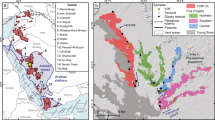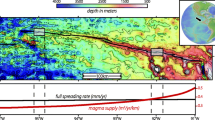Abstract
The Muliwai a Pele lava channel was emplaced during the final stage of Mauna Ulu’s 1969–1974 eruption (Kilauea, Hawaii). The event was fountain-fed and lasted for around 50 h, during which time a channelized flow system developed, in which a 6-km channel fed a zone of dispersed flow that extended a further 2.6 km. The channel was surrounded by initial rubble levees of ’a’a, capped by overflow units of limited extent. We sampled the uppermost overflow unit every 250 m down the entire channel length, collecting, and analyzing 27 air-quenched samples. Bulk chemistry, density and textural analyses were carried out on the sample interior, and glass chemistry and microlite crystallization analyses were completed on the quenched crust. Thermal and rheological parameters (cooling, crystallization rate, viscosity, and yield strength) were also calculated. Results show that all parameters experience a change around 4.5 km from the vent. At this point, there is a lava surface transition from pahoehoe to ’a’a. Lava density, microlite content, viscosity, and yield strength all increase down channel, but vesicle content and lava temperature decrease. Cooling rates were 6.7 °C/km, with crystallization rates increasing from 0.03 Фc/km proximally, to 0.14 Фc/km distally. Modeling of the channel was carried out using the FLOWGO thermo-rheological model and allowed fits for temperature, microlite content, and channel width when run using a three-phase viscosity model based on a temperature-dependent viscosity relation derived for this lava. The down flow velocity profile suggests an initial velocity of 27 m/s, declining to 1 m/s at the end of the channel. Down-channel, lava underwent cooling that induced crystallization, causing both the lava viscosity and yield strength to increase. Moreover, lava underwent degassing and a subsequent vesicularity decrease. This aided in increasing viscosity, with the subsequent increase in shearing promoting a transition to ’a’a.













Similar content being viewed by others
References
Bottinga Y, Weill DF (1970) Densities of liquid silicate systems calculated from partial molar volumes of oxide components. Am J Sci 269:169–182
Cashman KV, Thornber C, Kauahikaua (1999) Cooling and crystallization of lava in open channels, and the transition of Pāhoehoe Lava to ‘A’ā. Bull Volcanol 61:306–323
Crisp J, Cashman KV, Bonini JA, Hougen SB, Pieri DC (1994) Crystallization history of the 1984 Mauna Loa lava flow. J Geophys Res 99:7177–7198
Einstein A (1906) Eine neue Bestimmung der Molekuldimension. Ann Phys 19:289–306
Fink JH, Zimbelman J (1990) Longitudinal variations in rheological properties of lavas: Puu Oo basalt flows, Kilauea Volcano, Hawaii. In: Fink JH (ed) Lavas flows and domes. Springer, Berlin, pp 157–173
Flynn LP, Mouginis-Mark PJ (1992) Cooling rate of an active Hawaiian lava flow from nighttime spectroradiometer measurements. Geophys Res Lett 19:1783–1786
Getson JM, Whittington AG (2007) Liquid and magma viscosity in the anorthite–forsterite–diopside–quartz system and implications for the viscosity-temperature paths of cooling magmas. J Geophys Res 112, B10203. doi:10.1029/2006JB004812
Gottsmann J, Harris AJL, Dingwell DB (2004) Thermal history of Hawaiian pāhoehoe lava crusts at the glass transition: implications for flow rheology and flow emplacement. Earth Planet Sci Lett 228:343–353
Gurioli L, Colo’ L, Bollasina AJ, Harris AJL, Whittington A, Ripepe M (2014) Dynamics of Strombolian explosions: inferences from field and laboratory studies of erupted bombs from Stromboli volcano. J Geophys Res. doi:10.1002/2013JB010355
Harris AJL, Allen JS III (2008) One-, two- and three-phase viscosity treatments for basaltic lava flows. J Geophys Res 113, B09212
Harris AJL, Rowland SK (2001) FLOWGO: a kinematic thermo-rheological model for lava flowing in a channel. Bull Volcanol 63:20–44
Harris AJL, Rowland SK (2014) FLOWGO 2012: an updated framework for thermo-rheological simulations of channel-contained lava. AGU Monograph Hawaiian Volcanism, from source to surface, in press
Harris AJL, Bailey J, Calvari S, Dehn J (2005) Heat loss measured at a lava channel and its implications for down-channel cooling and rheology. Geol Soc Am Spec Pap 396:125–146
Harris AJL, Favalli M, Mazzarini F, Hamilton CW (2009) Construction dynamics of a lava channel. Bull Volcanol 71:459–474
Heath TL (1897) The works of Archimedes. Cambridge University Press
Helz RT, Thornber CR (1987) Geothermometry of Kilauea Iki lava lake, Hawaii. Bull Volcanol 49:651–668
Helz RT, Heliker C, Hon K, Mangan M (2003) Thermal efficiency of lava tubes in the Pu’u ‘O’o-Kupaianaha eruption. In: Heliker C, Swanson DA, Takahashi TJ (eds) The Pu’u ‘O’o-Kupaianaha eruption of Kilauea volcano, Hawai’i: the first 20 years. US Geol Survey Prof Pap 1676:105–120
Hon K, Kauahikaua J, Denlinger R, Mackay K (1994) Emplacement and inflation of pahoehoe sheet flows: observations and measurements of active lava flows on Kilauea Volcano, Hawaii. Geol Soc Am Bull 106:351–370
Houghton BF, Wilson CJN (1989) A vesicularity index for pyroclastic deposits. Bull Volcanol 51:451–462
Hulme G (1974) The interpretation of lava flow morphology. Geophys J R Astron Soc 39:361–383
Jaggar TA (1920) Seismometric investigation of the Hawaiian lava column. Bull Seismol Soc Am 10:155–275
Lange RA (1994) The effect of H2O, CO2 and F on the density and viscosity of silicate melts. In: Carroll MR, Holloway JR (eds) Volatiles in magmas. Mineral Soc Am Rev Mineral 30
Lipman PW, Banks NG (1984) ‘A’ā flow dynamics, Mauna Loa 1984. In: Decker RW, Wright TL, Stauffer PH (eds) Volcanism in Hawaii, volume 2. US Geol Survey Prof Pap 1350:1527–1567
Llewellin EW, Manga M (2005) Bubble suspension rheology and implications for conduit flow. J Volcanol Geotherm Res 143:205–217
Macdonald GA (1953) Pâhoehoe, ‘a’â, and block lava. Am J Sci 251:169–191
Moore HJ (1987) Preliminary estimates of the rheological properties of 1984 Mauna Loa lava. In: Decker RW, Wright TL, Stauffer PH (eds) Volcanism in Hawaii, volume 2. US Geol Survey Prof Pap 1350:1569–1588
Osmond DI, Griffiths RW (2001) The static shape of yield strength fluids slowly emplaced on slopes. J Geophys Res 106:16,241–16,250
Peterson DW, Tilling RI (1980) Transition of basaltic lava from pahoehoe to ’a’a, Kilauea volcano, Hawaii: field observations and key factors. J Volcanol Geotherm Res 7(3/4):271–293
Peterson DW, Christiansen RL, Duffield WA, Holcomb RT, Tilling RI (1976) Recent activity of Kilauea Volcano, Hawaii. Proceedings of the symposium on “Andean and Antarctic volcanology problems” (Santiago, Chile, September 1974), pp 646–656. Edited by O. Gonzales Ferran, executive secretary of the organizing committee
Phan-Thien N, Pham DC (1997) Differential multiphase models for polydispersed suspensions and particulate solids. J Non-Newtonian Fluid Mech 72:305–318
Pinkerton H, Sparks RSJ (1978) Field measurements of the rheology of lava. Nature 276:383–385
Pinkerton H, James M, Jones A (2002) Surface temperature measurements of active lava flows on Kilauea volcano, Hawai’i. J Volcanol Geotherm Res 113:159–176
Pinkerton H, Stevenson RJ (1992) Methods of determining the rheological properties of magmas at sub-liquidus temperatures. J Volcanol Geotherm Res 53(1–4):47–66, doi:10.1016/0377-0273(92)90073-M
Polacci M, Cashman KV, Kauahikaua JP (1999) Textural characterization of the pāhoehoe-‘a’ā transition in Hawaiian basalt. Bull Volcanol 60:595–609
Richter DH, Eaton JP, Murata KJ, Ault WU, Krivoy HL (1970) Chronological narrative of the 1959–60 eruption of Kilauea Volcano. Hawaii US Geol Surv Prof Pap 537-E
Riker JM, Cashman KV, Kauahikaua JP, Montierth CM (2009) The length of channelized lava flows: insight from the 1859 eruption of Mauna Loa Volcano, Hawaii. J Volcanol Geotherm Res 183:139–156
Roscoe R (1952) The viscosity of suspensions of rigid spheres. Br J Appl Phys 3:267–269
Rowland SK, Walker GPL (1990) Pahoehoe and aa in Hawaii: volumetric flow rate controls the lava structure. Bull Volcanol 52:615–628
Shaw HR (1972) Viscosities of magmatic silicate liquids: an empirical method of prediction. Am J Sci 272:870–893
Shea T, Houghton BF, Gurioli L, Cashman KV, Hammer JE, Hobden BJ (2010) Textural studies of vesicles in volcanic rocks: an integrated methodology. J Volcanol Geotherm Res 190:271–289
Soule SA, Cashman KV (2005) Shear rate dependence of the pahoehoe to ‘a‘a transition: analog experiments. Geol 33(5): 361–364
Soule SA, Cashman KV, Kauahikaua JP (2004) Examining flow emplacement through the surface morphology of three rapidly emplaced, solidified lava flows, Kilauea Volcano, Hawaii. Bull Volcanol 66:1–14
Sparks RSJ, Pinkerton H (1978) Effect of degassing on rheology of basaltic lava. Nature 276:385–386
Swanson DA, Duffield WA, Jackson DB, Peterson DW (1979) Chronological narrative of the 1969–71 Mauna Ulu eruption of Kilauea Volcano, Hawaii. US Geol Survey Prof Pap 1056
Tilling RI, Christiansen RL, Duffield WA, Endo ET, Holcomb RT, Koyanagi RY, Peterson DW, Unger JD (1987) The 1972–1974 Mauna Ulu eruption, Kilauea Volcano: an example of quasi-steady-state magma transfer. In: Decker RW, Wright TL, Stauffer PH (eds) Volcanism in Hawaii, volume 1. US Geol Survey Prof Pap 1350:405–470
Vogel DH (1921) Temperaturabhängigkeitsgesetz der Viskosität von Flüssigkeiten. Zeit Phys Chem 22:645–646
Wadge G, Lopes RMC (1991) The lobes of lava flows on Earth and Olympus Mons, Mars. Bull Volcanol 54:10–24
Whittington AG, Hellwig BM, Behrens H, Joachim B, Stechern A, Vetere F (2009) The viscosity of hydrous dacitic liquids: implications for the rheology of evolving silicic magmas. Bull Volcanol 71:185–199
Wolfe EW, Neal CA, Banks NG, Duggan TJ (1988) Geologic observations and chronology of eruptive events. In: The Puu Oo eruption of Kilauea Volcano, Hawaii: episodes 1 through 20, January 3, 1983, through June 8, 1984. U.S. Geol Survey Prof Pap 1463, pp 1–97
Acknowledgments
AW and AS were supported by NSF grant EAR-1220051 and NASA grant NNX12AO44G. We thank the National Park Service for granting us a research and sampling permit. This is Laboratory of Excellence CLERVOLC contribution 97.
Author information
Authors and Affiliations
Corresponding author
Additional information
Editorial responsibility: S. Calvari
Electronic supplementary material
Below is the link to the electronic supplementary material.
Appendix 1
Sample descriptions and characteristics (SG Smooth Golden, Phh Pahoehoe, trans transition). While sheet flows are extensive smooth surfaced sheets of pahoehoe, lobes are small paohoehoe toes. (DOC 71 kb)
Appendix 2
Major element bulk chemistry data (wt%). Analytical error (2σ) are 0.91 % for SiO2, 1.71 % for Al2O3, 0.37 % for Fe2O3, 1.60 % for MgO, 0.23 % for CaO, 1.41 % for Na2O, 7.93 % for K2O, 3.69 % for TiO2, 1.94 % for MnO, and 2.82 % for P2O5 (DOC 73 kb)
Appendix 3
a) Textural characteristics of each sample (N vcorr is the vesicle number density per volume corrected for vesicularity and crystallinity) (DOC 39 kb)
4
b) Comparison between overflow samples and their pond (P), spatter (Sp), and tube roof (TR) equivalent samples (JPEG 2648 kb)
Appendix 5
Viscosity data for remelted Mauna Ulu basalt. For high temperature viscosity measurements, at each temperature, three individual measurements with durations of 5 min of stable readings at different angular velocities have been conducted. Around 1230.7 °C, viscosity steadily increases, indicating sufficient undercooling allowing crystallization to occur. For low temperature viscosity measurements, measurements were made on two cylindrical sample cores A and B (DOC 51 kb)
Rights and permissions
About this article
Cite this article
Robert, B., Harris, A., Gurioli, L. et al. Textural and rheological evolution of basalt flowing down a lava channel. Bull Volcanol 76, 824 (2014). https://doi.org/10.1007/s00445-014-0824-8
Received:
Accepted:
Published:
DOI: https://doi.org/10.1007/s00445-014-0824-8




